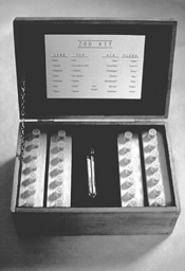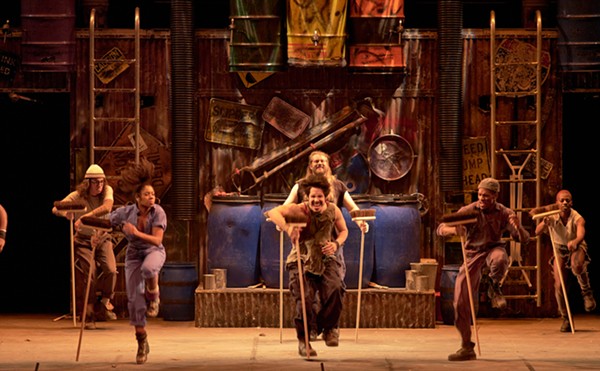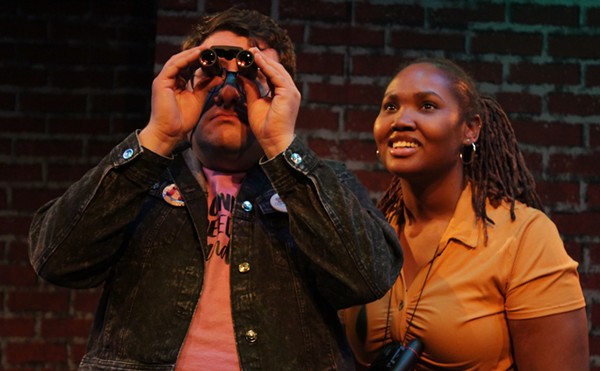No one is going to win the Tour de France with any of the five bicycles that Brower is displaying. The gallery invites viewers to try them out, but, in a printed disclaimer hung on an adjacent wall, warns that they do so at their own risk. Aside from the one with octagonal wheels, there is the creation with two seats and two sets of pedals. Nothing unusual about that. There is a catch, though. The wheels move in opposite directions when both riders are pedaling. This is all amusing (it evokes those Far Side cartoons about early experiments in transportation), but one suspects that the artist has placed these nonfunctional monstrosities here with something else -- something rather more disturbing -- in mind.
That something else is suggested by the title of the show. In chess, the endgame begins when it's obvious which side will win, but the players nevertheless go through their paces. The title also resonates with the Samuel Beckett play of the same name. In the play, the central character knows that there is no way out of the claustrophobic interior of a nuclear shelter. This doomed character nevertheless plays out his moves, knowing full well that they are pointless.
Brower and the other artists in this show confront the machine at the end of the millennium, but in their work, it seems as though the machine has won and humanity has lost. The best the artist can do, we seem to be told, is to set up a small world with its own rules (bicycle wheels shall henceforth be not round but octagonal) and thus stay alive by ordering his art as though it were a chessboard. Although the bicycles are not good for riding -- they might even cause physical harm -- any movement is better than none. Even if we are doomed (the wheels moving in opposing directions), we still must play the endgame, because it's unsportsmanlike to quit the game.
If you haven't already guessed, this is a grim exhibit. As in absurdist theater, the farcical elements employed here are streaked with bitterness. The question is whether the work comes by its grimness legitimately or through trickery. Stated another way, is this the pessimism typically found in late-night college bull sessions? Or is it an alternative arrived at after reflection? Unfortunately, the pessimism in this show tends to be of the late-night bull session variety. The art stays resolutely on the surface, and consequently, the dark mood seems glib.
Take, for instance, the work of Chicago artist Jason Lee. One of the electronic installations that he has on display hurls toilet paper. The viewer steps on a lever that, in turn, activates a mechanism that unfurls a roll of toilet paper at high speed. Nearby, there is a converted hat rack that holds extra toilet paper with which to feed the machine. Like Brower's bicycles, this is initially amusing. The idea is that the artist has gone through all this effort to create an object that doesn't really do anything. Energy is being used up (and the people at Charmin profit), but there won't be too many consumers in the market for an object that belches toilet paper. So what is going on here?
In Lee's view of the world, no one creates useful products anymore -- neither artists nor manufacturers. Consumers still buy them, however. This dynamic, Lee seems to say, points to cultural breakdown. His piece then becomes a springboard to a commentary about society. If only that commentary were original. We've already seen this sort of thing at Spaces before, when the Cincinnati-based art collective Todt came to town in April 1999. That group showed us contraptions that spun eggs at high speed and weed-whackers that made a lot of noise, but had no weeds to whack. This toilet paper contraption shares the same theme and similar treatment. It wasn't compelling then, and it's not now.
Two other Lee pieces are funnier, but no more effective. For example, in "Running Man," a video monitor shows us a man running in place. Put on the headphones, and you hear a stream-of-consciousness narrative by a male (the one on the video screen?) during which he babbles on about a night he spent at a bar with buddies, the robbery that ensued, and myriad other disappointments in his life. The funny thing is that the voice is robotic -- a metallic monotone all the way through. It sounds exactly like the voice that Stephen Hawking has been outfitted with, and to think of Hawking musing about the beginning of the universe and to simultaneously listen to these inane ramblings makes for a comic experience. The robotic person we listen to on the tape is truly running in place: He doesn't seem to have much of a clue about anything. That's all the viewer is left with.
"Tough Guy," another piece along the same lines, involves a video monitor that features the abusive ravings of a man who shouts at his unseen audience (us). In style, this character recalls Dana Carvey's "Grumpy Old Man" routine from Saturday Night Live, with one major difference: This is a grumpy young man who hurls profanities, not platitudes about the good old days. He tells his (absent) girlfriend, in our presence, that, in his opinion, she's just a glass of water, and to emphasize the point, Lee places a real glass of water on a nearby pedestal. What this has to do with confronting the machine is anyone's guess, but one thing is for sure. All this abusive shouting becomes boring after a while. Bring back the Grumpy Old Man.
The work of Berkeley, California artist Gail Wight documents the attempts of an artist who has gone to some pretty extreme measures in her quest to "understand Thinking" (her capitalization). In an artist's statement, she tells of having designed "an artificial intelligence to read my tarot" and of having "conducted biochemical experiments on myself and others." She tells of dissecting machines and of then failing to put them back together, and asks tantalizingly, "Is a machine more or less reliable due to its lack of endorphins, emotions, and opiate addictions?" Despite (or maybe because of) the bizarre mixture of influences suggested by her statement, Wight comes up with the most interesting piece in the show. It's called "Zoo Kit," and it consists of a box of test tubes arranged in neat rows. Supposedly, they all hold DNA. There is a page of text on the upper portion of the opened box that tells of the contents. This reminds one of those chocolate boxes that tell precisely where each type of sweet is located. The difference here is that we are told not about caramels or soft centers, but rather where the DNA of a lion, tiger, bee, or flamingo will be found. To cap things off, there is a test tube marked "Zoo Keeper."
This is a chilling piece. It's simple, like some of the other work in this show, but its simplicity conceals depth. In the context of an exhibit subtitled "Artists Confront the Machine," Wight's "Zoo Kit" successfully stimulates thought about what it might mean if a computer could assemble a box like this. Perhaps Hal, the homicidal computer from 2001: A Space Odyssey, might have compiled such a box if he had survived the film.
Aside from Wight, no one is successful in this doomsday chess game. The artists go through the paces, but they don't win the match.













